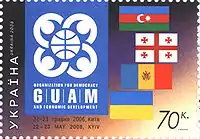GUAM Organization for Democracy and Economic Development
The GUAM Organization for Democracy and Economic Development is a regional organization of four post-Soviet states: Georgia, Ukraine, Azerbaijan, and Moldova.
GUAM Organization for Democracy and Economic Development
| |
|---|---|
 Logo
| |
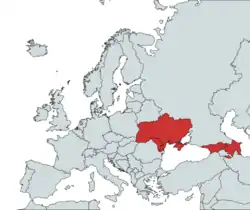 GUAM members in red | |
| Headquarters | Kyiv, Ukraine |
| Official language | English |
| Member states |
|
| Establishment | |
• GUAM consultative forum | 10 October 1997 |
• Uzbekistan membership, GUUAM established | 1999 |
• Charter signed | June 2001 |
• Uzbekistan withdrew, GUAM reestablished | May 2005 |
| Area | |
• Total | 810,506 km2 (312,938 sq mi) |
| Population | |
• 2020 estimate | |
• Density | 71.5/km2 (185.2/sq mi) |
| GDP (PPP) | 2020 estimate |
• Total | |
• Per capita | $14,000 |
| GDP (nominal) | 2020 estimate |
• Total | |
• Per capita | $4,055 |
Website guam-organization.org | |
Conceived in 1997 to harmonize and integrate commercial, diplomatic and democratic relations among its member states, GUAM treaty charter was signed in 2001 and today covers a population of over 57 million people. Uzbekistan was also a member of GUAM in 1999–2005 period. In 2007, GUAM also established a military peacekeeping force and organized joint military exercises. Such increasingly deepened integration and relationships, led GUAM in playing an important role in the region's diplomatic and commercial affairs.
The official negotiating language of GUAM was Russian, but it was scrapped in favor of English in 2014. In 2017, agreements on a free-trade area were established for the first time.
History
Origins and foundation, Uzbek membership (1997–2005)
Cooperation between Georgia, Ukraine, Azerbaijan, and Moldova started with the "GUAM consultative forum", established on 10 October 1997, in Strasbourg and named after the initial letters of each of those countries. In 1999, the organisation adopted the name GUUAM due to the membership of Uzbekistan. A summit in Yalta on 6 to 7 June 2001, was accompanied by the signing of GUUAM's charter which formalized the organization. According to the former Ukrainian President Viktor Yushchenko the charter set objectives for cooperation, such as promoting democratic values, ensuring stable development, enhancing international and regional security and stepping up European integration.[2]
In 2002, Uzbekistan announced that it planned to withdraw from the organization and following this announcement started to ignore GUUAM summits and meetings.[3] In May 2005, shortly after the Andijan massacre, Uzbekistan finally gave an official notice of withdrawal from the organization to the Moldovan presidency, thus changing the group's name back to GUAM.
A summit of GUUAM took place in Chișinău, Moldova, on 22 April 2005. The US Department of State special representative for Eurasian conflicts, Steven Mann, and the OSCE Secretary General Ján Kubiš participated the summit. The Russian ambassador in Chișinău criticized the fact that Russia was not invited to attend.[4] Ilham Aliyev, the president of Azerbaijan, said after the summit: "Our organization is emerging as a powerful force, participating in resolving problems in the Caspian—Black Sea region" while the president of Ukraine, Viktor Yushchenko, said that a new page had been written in the history of the organization.[5]
Deepening of relations and integration (2006–2013)
Given the growth of its influence in the region, and the existence of the Russian—led Commonwealth of Independent States (CIS), GUAM was seen in Russia as a way of countering the Russian influence in the area and as part of a strategy backed by the United States.[6] However, GUAM leaders repeatedly and officially dismiss such claims and declare their strong willingness to develop close friendly relations with Russia. Moreover, Azerbaijan, the group's main energy power, has managed to avoid any conflicts with Russia in recent years.
In April 2006, three GUAM nations supported Ukraine's proposal to condemn the Holodomor, the 1930s famine in Ukraine which killed millions of people, as a genocide.[7]
In May 2006, Ukraine and Azerbaijan announced plans to further increase the GUAM member relations by renaming the organization GUAM Organization for Democracy and Economic Development and establishing its headquarters in the Ukrainian capital.[8] The other members said this was a remarkable step and development. The summit participants were also expected to adopt GUAM by—laws, a declaration and a communique. Also in May 2006 the Ukrainian Defense Ministry announced plans to establish GUAM peacekeeping forces.[9] The following year, GUAM nations agreed to form a 500-personnel joint peacekeeping force to battle separatism.
In June 2007, presidents of Lithuania, Poland and Romania joined the leaders of GUAM member states at the GUAM summit in Baku, Azerbaijan. Also participating at the summit were the Vice-President of Bulgaria, the Vice-Speaker of the Estonian parliament, the Minister of Economy of Latvia, and the high—level representatives of the United States, Japan, the Organization for Security and Co-operation in Europe (OSCE), the Organization of the Black Sea Economic Cooperation (BSEC), UNESCO, and heads of diplomatic missions accredited in Azerbaijan.[10]
After Russian invasion and annexation of Crimea (2014–present)
Russian meddling and Vladimir Putin's aggressive foreign policy, culminated in the invasion and annexation of Crimea in March 2014, pushed GUAM towards Western integration. In December 2014, then Ukrainian Foreign Minister Pavlo Klimkin proposed GUAM to speak English during meetings, instead of Russian, which was also the main language used in official gatherings in the Soviet Union. GUAM representatives agreed.[11][12]
In March 2017, GUAM officially established agreements on a free-trade area and harmonization of customs procedures within its member states.[13]
Members
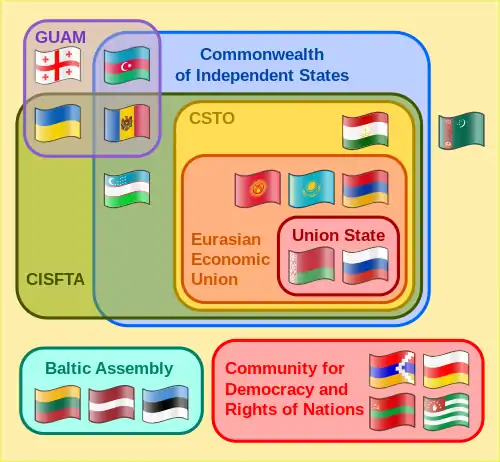
- Current
 Georgia (1997) ("G")
Georgia (1997) ("G")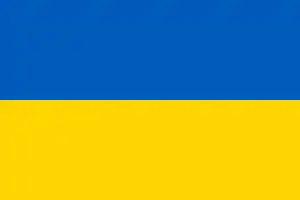 Ukraine (1997) ("U")
Ukraine (1997) ("U")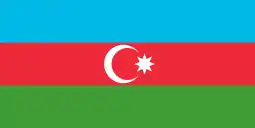 Azerbaijan (1997) ("A")
Azerbaijan (1997) ("A")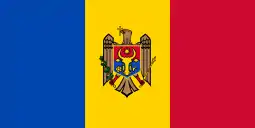 Moldova (1997) ("M")
Moldova (1997) ("M")
- Former
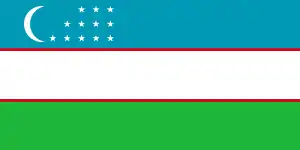 Uzbekistan (1999–2002)
Uzbekistan (1999–2002)
See also
- Politics of Europe
- Post-Soviet states
- Commonwealth of Independent States
- Community of Democratic Choice
- Shanghai Cooperation Organization
- Community for Democracy and Rights of Nations
- Euronest Parliamentary Assembly
- Black Sea Forum
- Military of Georgia
- Military of Ukraine
- Military of Azerbaijan
- Military of Moldova
- TRACECA
References
- "Report for Selected Countries and Subjects: October 2020". International Monetary Fund. Retrieved 13 November 2020.
- "Russian Deputy FM: "GUAM not anti-Russian group"". Today.az. 23 May 2006. Retrieved 18 April 2007.
- "Uzbekistan: Tashkent Withdraws From GUUAM, Remaining Members Forge Ahead". Radio Free Europe/Radio Liberty. 18 June 2002. Retrieved 13 November 2020.
- "Itar-Tass article". Itar-Tass. Archived from the original on 30 September 2007. Retrieved 18 April 2007.
- "GUAM Leaders Hail Chişinău Summit". Civil Georgia. 22 April 2005. Retrieved 18 April 2007.
- "Axis of Evil Shaping Against Moscow". Kommersant. 3 March 2005. Archived from the original on 20 May 2014. Retrieved 18 April 2007.
- "CIS Split at Ministerial Conference". Eurasia Daily Monitor. 25 April 2006. Archived from the original on 17 April 2007. Retrieved 18 April 2007.
- "Foreign Ministers of Georgia, Ukraine, Azerbaijan and Moldova Discussed the Upcoming Guam Summit". InfoMarket. Moldova Azi. 19 May 2006. Retrieved 18 April 2007.
- "Ukraine suggests setting up GUAM peacekeeping unit". Today.az. 31 May 2006. Retrieved 18 April 2007.
- "Embassy of Azerbaijan in the U.S.: Baku hosts GUAM Second Summit". Archived from the original on 27 September 2007. Retrieved 24 August 2007.
- "Ex-Soviet GUAM Switches To English". RadioFreeEurope/RadioLiberty. Retrieved 7 April 2018.
- "Ex-Soviet GUAM Group Drops Russian, Switches To English". Radio Free Europe/Radio Liberty. 5 December 2014. Retrieved 14 January 2015.
- "In the framework of the GUAM summit governments of Georgia, Ukraine, Azerbaijan and Moldova signed protocols on the establishment of the FTA and mutual recognition of results of customs control procedures". Government of Ukraine. 27 March 2017. Retrieved 13 November 2020.
External links
- "Official website". GUAM Organization for Democracy and Economic Development. Archived from the original on 27 December 2008. Retrieved 18 April 2007.
- "Ukraine suggests setting up GUAM peacekeeping unit". Today.az. 31 May 2006. Retrieved 18 April 2007.
- "Azerbaijan-GUAM". Ministry of Foreign Affairs of Azerbaijan. Archived from the original on 16 April 2007. Retrieved 18 April 2007.
- "Ukrainian President Yushchenko: "GUAM will acquire the status of an international organization May 23"". Today.az. 18 May 2006. Retrieved 18 April 2007.
- GUAM News (subscribers only)
- Baku Today
- "Ukraine says GUAM must focus on cooperation with EU, NATO". Today.az. 23 May 2006. Retrieved 18 April 2007.
- "Official website". INSTC (International North-South Transport Corridor). Archived from the original on 5 July 2008. Retrieved 18 April 2007.
- "The GUUAM Group: History and Principles". guuam.org. Archived from the original on 28 July 2007. Retrieved 12 June 2007.
- "Welcome to TRACECA". TRACECA (Transport Corridor Europe Caucasus Asia) IGC. Retrieved 12 June 2007.
- "GUAM Group". Eurasian Home. Archived from the original on 1 September 2007. Retrieved 12 June 2007.
